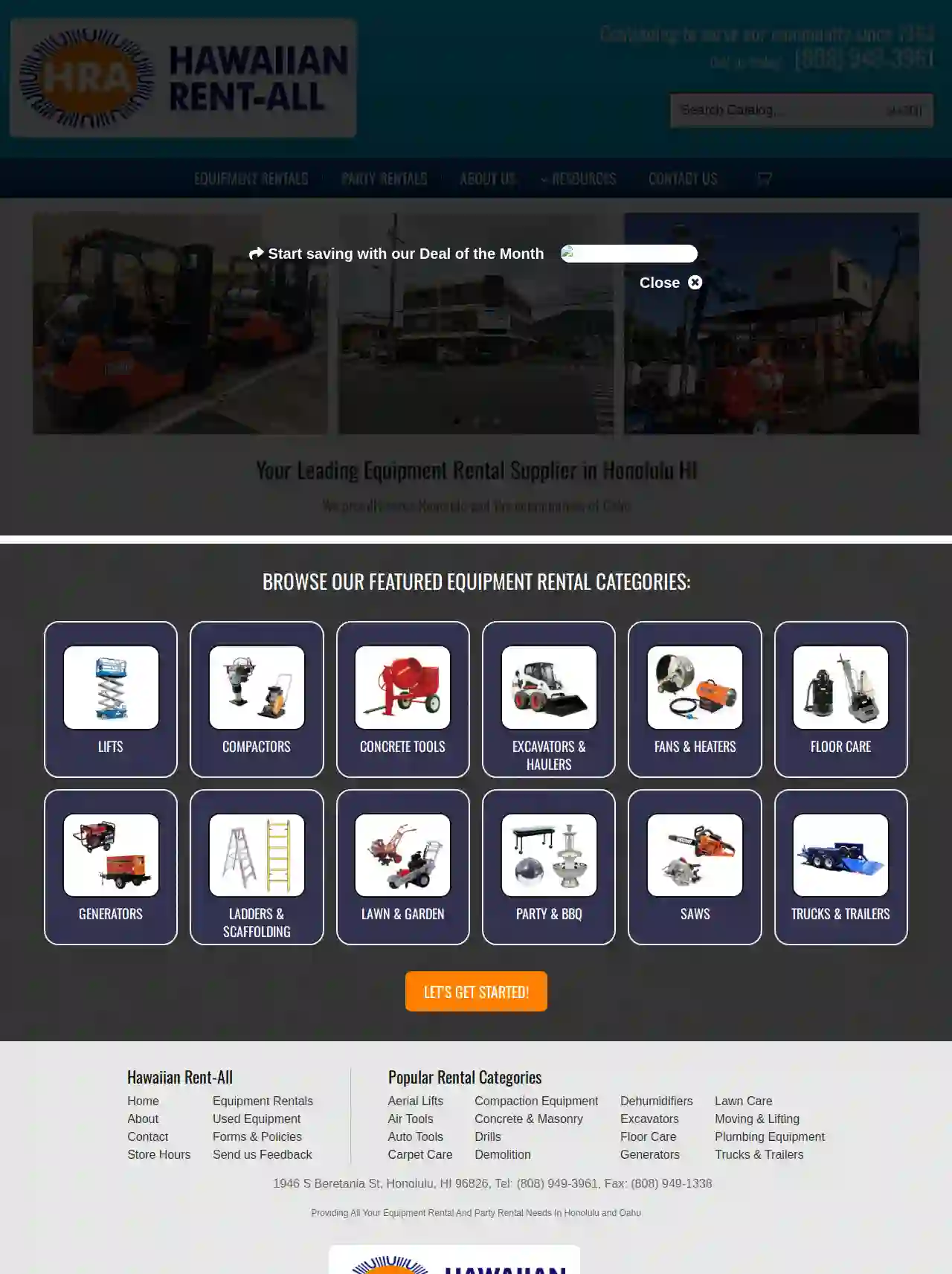Scaffolding Companies Pupukea
Top 10 Scaffolding Company in Pupukea
Receive multiple Scaffolding Erectors quotes for your project today! Compare profiles, reviews, accreditations, portfolio, etc... and choose the best deal.

Hawaiian Rent-All
4.1110 reviews1946 S Beretania St, Honolulu, 96826, USContinuing to serve our community since 1964, Hawaiian Rent-All is your leading equipment rental supplier in Honolulu, HI. We proudly serve Honolulu and the communities of Oahu. With a wide range of equipment rental categories, including lifts, compactors, concrete tools, excavators & haulers, fans & heaters, floor care, generators, ladders & scaffolding, lawn & garden, party & BBQ, and saws, we have everything you need to get started. Our team is dedicated to providing all your equipment rental and party rental needs in Honolulu and Oahu. Contact us today at (808) 949-3961 or visit our store at 1946 S Beretania St, Honolulu, HI 96826.
- Services
- Why Us?
- Accreditations
- Gallery
Get Quote
GWS Consulting LLC
Oahu, USAt GWS Consulting LLC, we are a scaffold rental company serving clients on Oahu. We design, estimate, build, and dismantle a variety of scaffolding systems based on your needs. Our team has years of experience in the scaffold industry and provides quality work to help meet your needs. From design and estimate to execution, GWS will serve you every step of the way. We offer a variety of access solutions to get your project going safely and without a hitch. From residential, commercial, to industrial projects, our teams will provide solutions that meet your needs.
- Services
- Why Us?
- Gallery
Get Quote
Statewide General Contracting & Construction, Inc
4.48 reviews746 Bannister St, Honolulu, 96819, USStatewide General Contracting & Construction Inc. was founded on the idea of providing results efficiently. With a background in the industry spanning 15 years, the company believes that the combination of knowledge, integrity, and commitment to the job are the components of success in gaining market share, resulting in rave reviews and customer satisfaction for many years. The company's mission is to build dreams.
- Services
- Why Us?
- Accreditations
- Our Team
- Testimonials
- Gallery
Get Quote
J&B Materials
4.929 reviewsEl Cajon, CA, 1165 N. Johnson Ave., 92020, USJ & B Materials is a leading provider of building materials and construction supplies. With multiple locations across California and Hawaii, we offer a wide range of products and services to meet the needs of contractors, builders, and DIYers. Our team of experts is dedicated to providing exceptional customer service, expert advice, and timely delivery to ensure your project is completed on time and within budget.
- Services
- Why Us?
- Gallery
Get Quote- Fr
Fred Rader Mill Supply
4.76 reviewsHonolulu, US- Services
- Why Us?
Get Quote - Br
BrandSafway Services Kapolei
4.69 reviewsHonolulu, US- Services
- Why Us?
Get Quote - To
Tool & Truck Rental at The Home Depot
39 reviewsHonolulu, US- Services
- Why Us?
Get Quote - Sk
Sky Climber of Hawaii
53 reviewsHonolulu, US- Services
- Why Us?
Get Quote - Su
Sunbelt Rentals
4.54 reviewsHonolulu, US- Services
- Why Us?
Get Quote - FK
FKS Rentals & Sales
Honolulu, US- Services
- Why Us?
Get Quote
Over 2,353+ Scaffolding Businesses onboarded
Our scaffolding contractors operate in Pupukea & beyond!
ScaffoldingHQ has curated and vetted Top Scaffolding Companies in and around Pupukea. Find a trustworthy contractor today.
Frequently Asked Questions About Scaffolding Companies
- Work at Height Regulations 2005: Covers all work at height and outlines the need for risk assessments, competent erectors, and safe equipment.
- Construction (Design and Management) Regulations 2015 (CDM): Applies to construction projects and requires planning for scaffolding safety throughout the project lifecycle.
- British Standard BS EN 12811: Sets standards for the design, manufacture, and testing of scaffolding components.
- NASC (National Access & Scaffolding Confederation) Guidance: Provides industry best practices and safety recommendations for scaffolding.
- Workers: Consider the number of workers on the scaffolding at any given time.
- Materials: Include the weight of building materials, tools, and equipment being used on the platform.
- Environmental Factors: Factor in potential loads from wind or snow, especially for taller scaffolding structures.
- A larger, more complex structure typically used for accessing multiple levels of a building.
- Offers greater height and versatility.
- Often used for construction, renovation, and maintenance.
- Smaller, portable platforms usually used for tasks at a single level.
- Commonly used for painting, plastering, or light repairs.
- Can be rolling or stationary.
What are the safety regulations for scaffolding in the USA?
What is the weight limit for scaffolding?
Can I erect scaffolding myself?
What is the difference between scaffolding and staging?
Scaffolding:
What are the safety regulations for scaffolding in the USA?
- Work at Height Regulations 2005: Covers all work at height and outlines the need for risk assessments, competent erectors, and safe equipment.
- Construction (Design and Management) Regulations 2015 (CDM): Applies to construction projects and requires planning for scaffolding safety throughout the project lifecycle.
- British Standard BS EN 12811: Sets standards for the design, manufacture, and testing of scaffolding components.
- NASC (National Access & Scaffolding Confederation) Guidance: Provides industry best practices and safety recommendations for scaffolding.
What is the weight limit for scaffolding?
- Workers: Consider the number of workers on the scaffolding at any given time.
- Materials: Include the weight of building materials, tools, and equipment being used on the platform.
- Environmental Factors: Factor in potential loads from wind or snow, especially for taller scaffolding structures.
Can I erect scaffolding myself?
What is the difference between scaffolding and staging?
Scaffolding:
- A larger, more complex structure typically used for accessing multiple levels of a building.
- Offers greater height and versatility.
- Often used for construction, renovation, and maintenance.
- Smaller, portable platforms usually used for tasks at a single level.
- Commonly used for painting, plastering, or light repairs.
- Can be rolling or stationary.